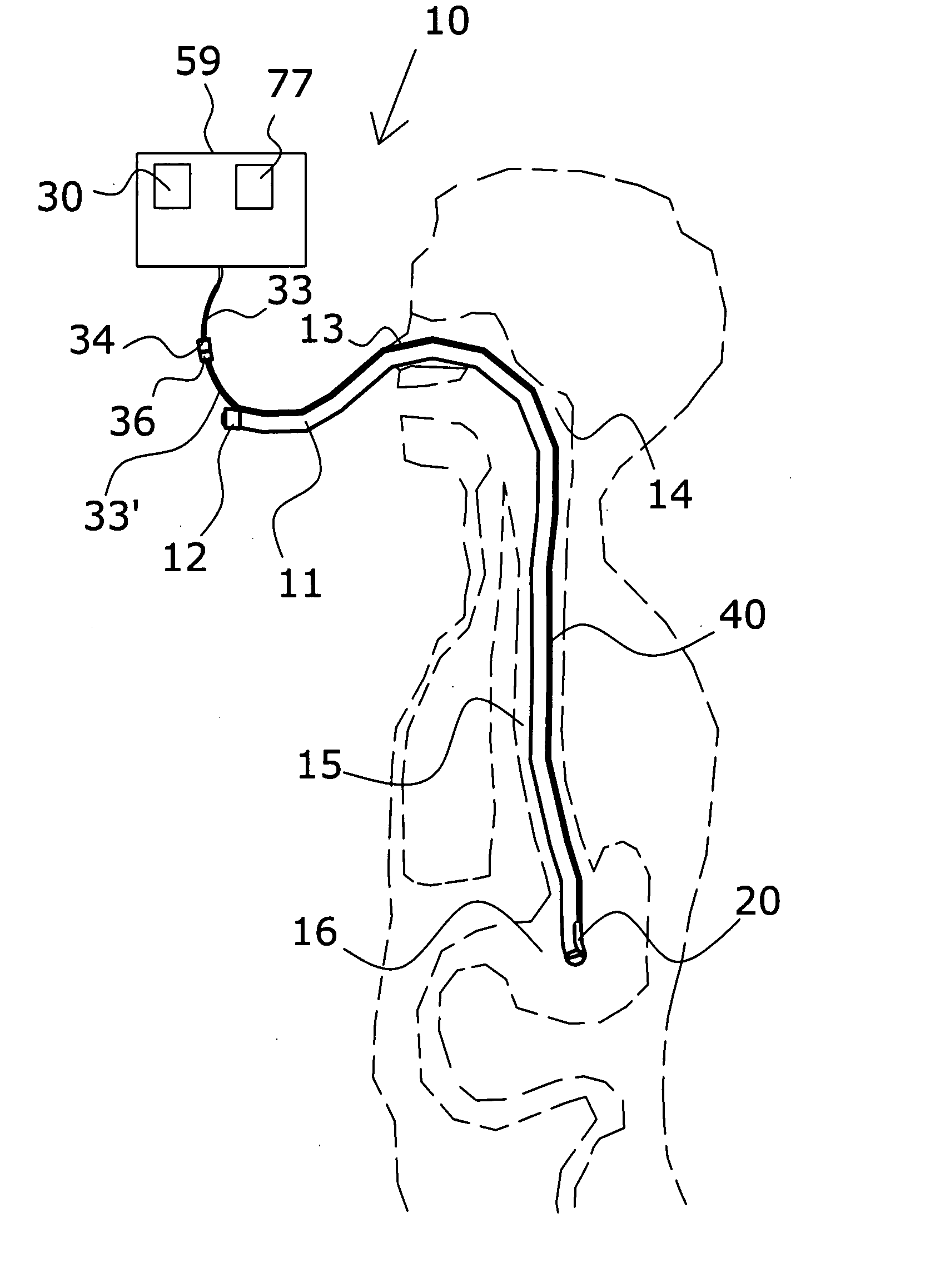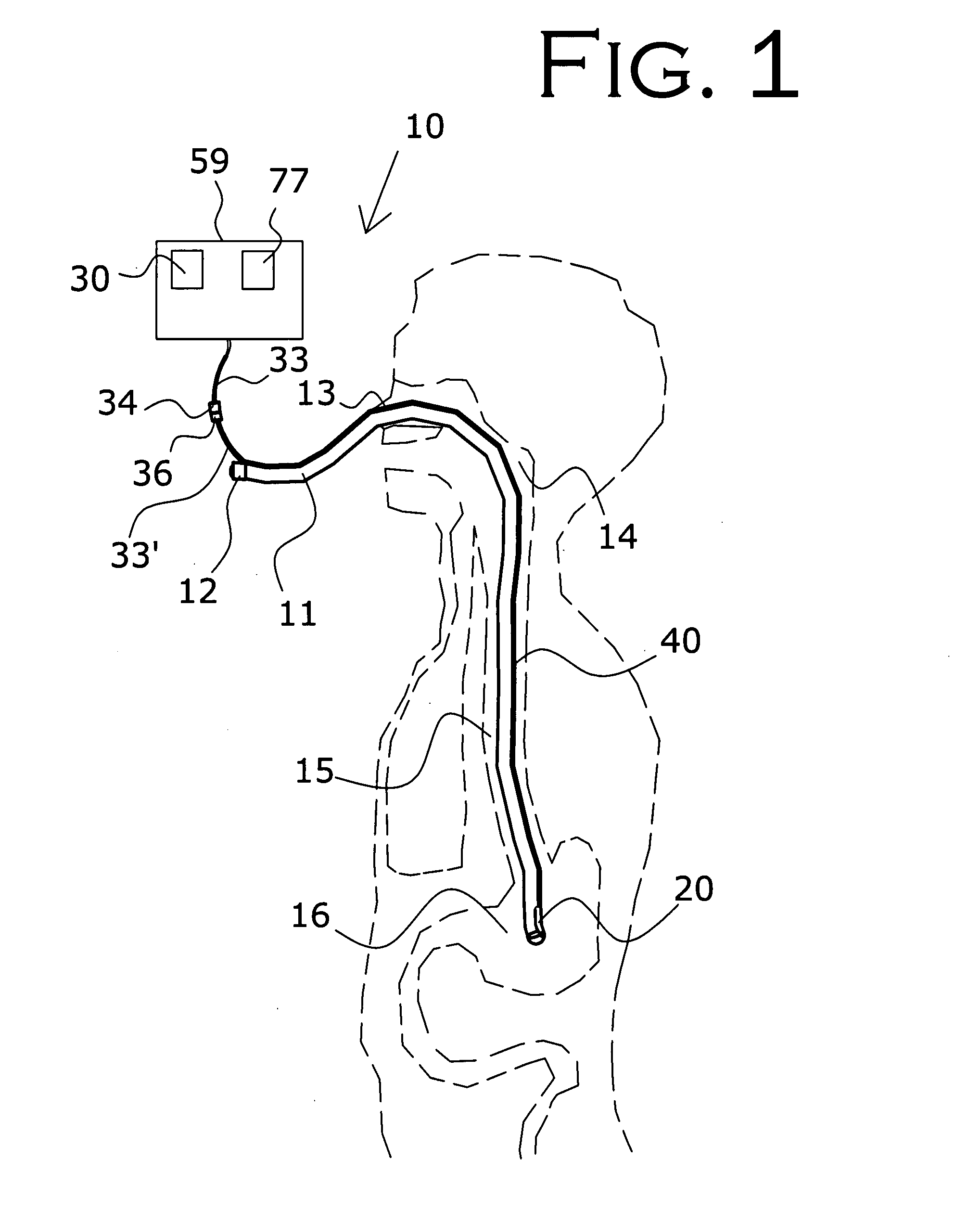Nasogastric tube placement and monitoring system
a monitoring system and nasogastric tube technology, applied in the field of nasogastric tube placement and monitoring system, can solve the problems of increasing the number of health problems of patients, difficult for clinicians to ensure proper placement of nasogastric tube, and the seriousness of aspiration by proxy, so as to increase the efficiency of staff.
- Summary
- Abstract
- Description
- Claims
- Application Information
AI Technical Summary
Benefits of technology
Problems solved by technology
Method used
Image
Examples
first embodiment
[0058]In the first embodiment, as seen in FIG. 2 and FIG. 3, a pH monitoring circuit and / or continuity circuit is provided. The feedback initiator 20 is a pH sensor 20a and / or continuity conductor 20e. PH sensor 20a continually senses the acidity or basicity of the fluid located at the distal end of flexible tube 11 by giving a measurement of the concentration of hydrogen ions. The continuity circuit, utilizing continuity conductor 20e, is a means of determining continuity through which the conductors continually monitor the conductivity of the fluid located at the distal end of the flexible tube 11, monitoring the presence of hydrogen ions.
[0059]The continuity circuit provides a potential to continuity conductor 20e at the distal end of flexible tube 11. Conducting means 40 is used as a means to provide or supply the potential to continuity conductor 20e, and, if continuity at continuity conductor 20e is available or detected, conducting means 40 further transmits the potential bac...
second embodiment
[0069]In the second embodiment, shown in FIG. 4 and FIG. 5, an audio monitoring circuit is illustrated, with the flowchart of FIG. 5 illustrating an overview of the operation of the audio monitoring circuit. The feedback initiator at the distal end of flexible tube 11 is an acoustic port 20b or opening using tube 11 as a means for sound to travel to the microphone 32 on the proximal end of tube 11, FIG. 4.
[0070]Feedback receiver 30b in the second embodiment preferably comprises a microphone 32 to receive the sounds from the distal end of flexible tube 11 configured with the appropriate amplifiers to amplify the received sounds and the appropriate circuitry to transmit the sounds via conducting means 40 to the speaker 38 which is configured with the appropriate circuitry to generate an audible sound that can be heard by the clinicians. The speaker 38 serves as a notifying device that provides the clinician with information concerning the distal end of flexible tube 11.
[0071]The sound...
third embodiment
[0072]In FIGS. 15 and 16 the third embodiment, the vibration circuit, is illustrated. A vibration vibrator 27 is provided to produce a pulsation or vibration to tube 11. The feedback initiator 20 is encapsulated beads 20y, disposed at the distal end of flexible tube 11. The encapsulated beads 20y are used to assist the clinician in determining the location of the distal end of tube 11. The encapsulated beads 20y may be any small contained objects that are space-efficient and generate an audible sound by agitation or repeated concussions. The vibration and sound from encapsulated beads 20y is received by feedback receiver 30y, the diaphragm 73 of handheld stethoscope 64, and transmitted by the stethoscope tubing to the earpieces 74. The clinician receives this sound that provides information about the distal end of flexible tube 11 via the earpieces of stethoscope 64 serving as a notifying device. Alternately, the audio monitoring circuit of FIG. 4 and FIG. 5 can be utilized with thi...
PUM
 Login to View More
Login to View More Abstract
Description
Claims
Application Information
 Login to View More
Login to View More - R&D
- Intellectual Property
- Life Sciences
- Materials
- Tech Scout
- Unparalleled Data Quality
- Higher Quality Content
- 60% Fewer Hallucinations
Browse by: Latest US Patents, China's latest patents, Technical Efficacy Thesaurus, Application Domain, Technology Topic, Popular Technical Reports.
© 2025 PatSnap. All rights reserved.Legal|Privacy policy|Modern Slavery Act Transparency Statement|Sitemap|About US| Contact US: help@patsnap.com



